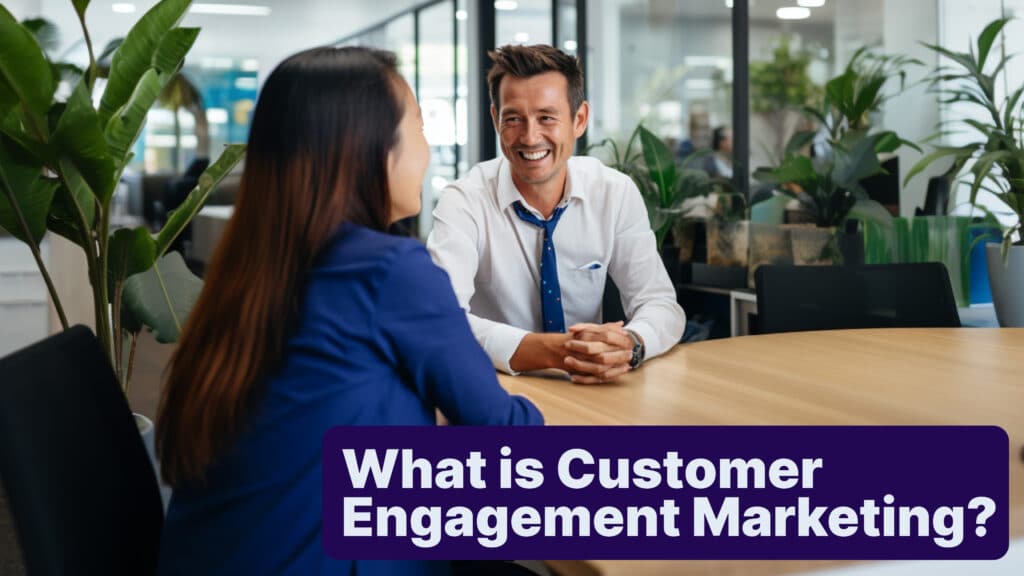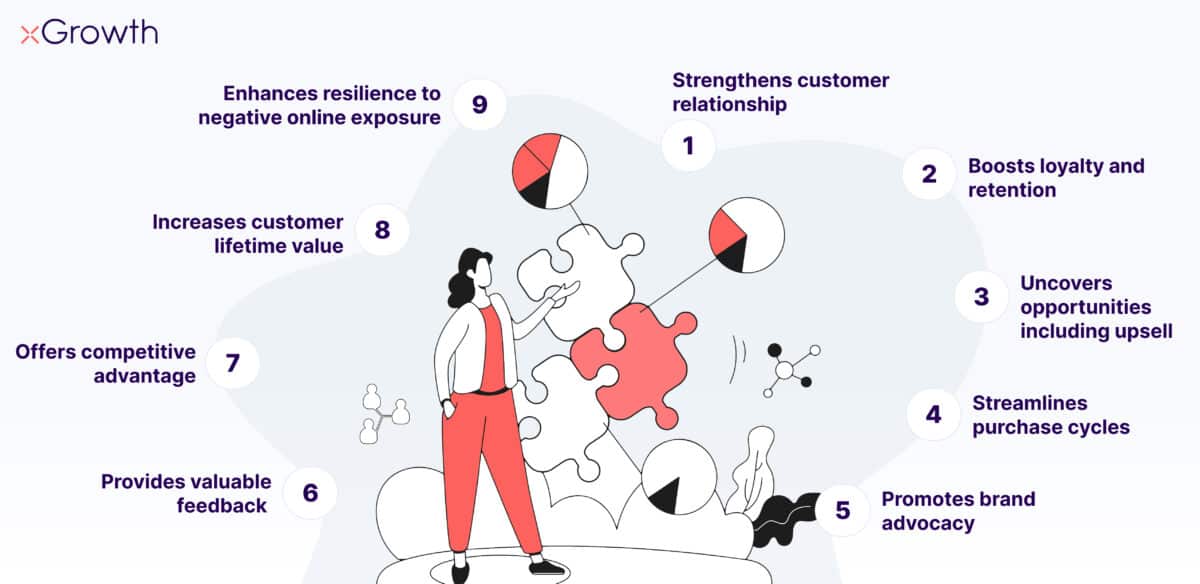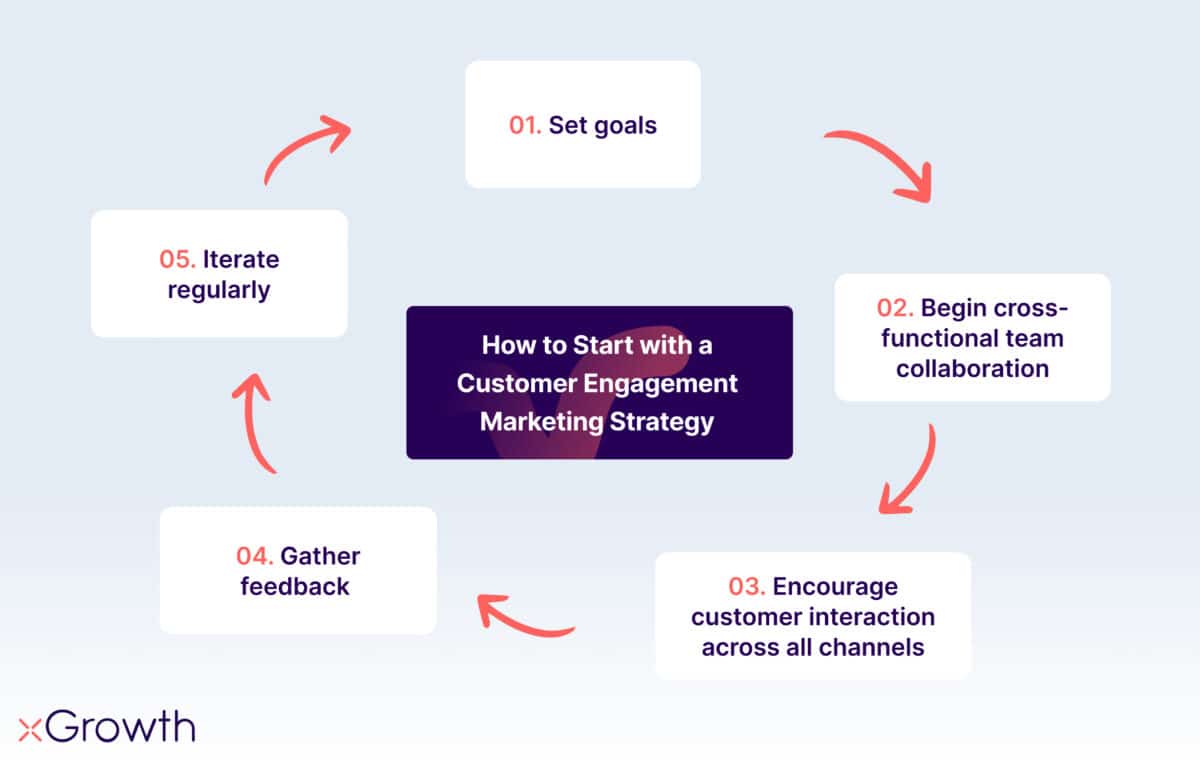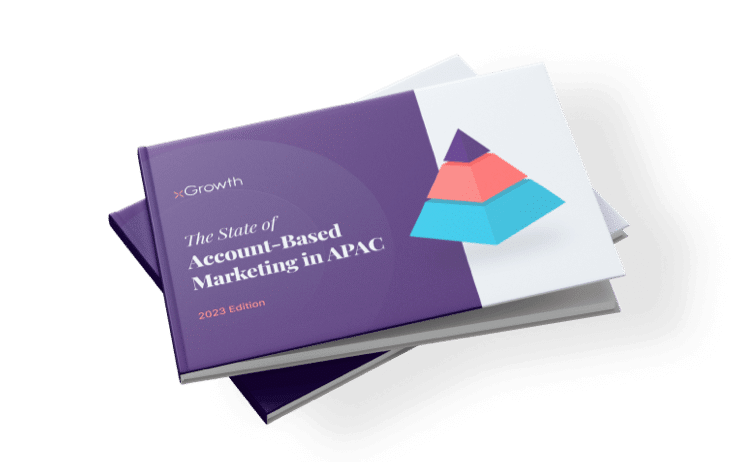Customer engagement marketing stands at the forefront of business strategies in the rapidly changing digital landscape. Today, consumers interact with brands across various platforms, reshaping the traditional dynamics of customer-brand relationships. Yet, many businesses face challenges. With 66% of consumers ready to abandon a brand over impersonal experiences, companies must stay engaged with their customers.

In response to this rising demand for personalised interactions, several platforms — including social media networks, email marketing tools, and Customer Relationship Management (CRM) systems — have emerged, offering innovative tools to foster and enhance customer relationships. As the digital landscape becomes complex, the onus is on leaders to ensure their interactions remain relevant and resonant with their audience.
Throughout this article, we will explore the multifaceted world of customer engagement marketing, highlighting actionable strategies and insights to help brands navigate these uncharted waters and solidify their bond with customers.
What is Customer Engagement Marketing
Customer engagement marketing, also known as consumer engagement marketing, encompasses the methods and techniques brands employ to foster meaningful connections with their customers through all available channels and at every point of contact. It goes beyond just selling; it's about understanding customers' unique needs and desires, showing them they are valued, and fostering close relationships through more personalised advertising and marketing strategies.
The aim is to turn occasional buyers into dedicated fans who actively promote the brand to others. In short, it's about creating a win-win situation where customers are happy and businesses thrive.
Why is Customer Engagement Marketing Important?
Customer engagement is vital because it fosters a meaningful connection between your brand and its customers, promoting loyalty, trust, and repeat purchases. Feeling valued and understood, engaged customers often become advocates, boosting referral traffic and new customer acquisition. Furthermore, engagement allows businesses to gather critical feedback for continuous improvement and innovation, ultimately driving business growth and profitability.
Engagement also offers a competitive edge. In a saturated market, meaningful customer engagement can set a brand apart, reducing the likelihood of customers switching to competitors and making them more forgiving of mistakes. This emotional connection makes customers less price-sensitive and more loyal. Additionally, a community of engaged, loyal customers is invaluable in a digital world where online reviews and social media are pivotal.
Companies like Amazon and Netflix excel in customer engagement by serving personalised content globally. Amazon's homepage and Netflix's recommendations are tailored to individual preferences, even for different users on the same account, and updated in real-time, highlighting the importance of personalisation and real-time responsiveness in global customer engagement.
Importantly, Customer Engagement Marketing treats the audience as valued individuals, not just revenue sources. The focus is on the entire customer journey. This approach involves them in shaping the brand, fostering a sense of ownership and pride, and making them part of a community sharing their values and interests. This leads to a more satisfying and rewarding relationship with the brand.
Customer engagement marketing offers a wide range of benefits, briefly categorised as follows:

Benefits of Customer Engagement Marketing

With the progression of the digital age, customers seek meaningful interactions and personalised experiences beyond transactional relationships. This shift necessitates businesses to comprehend and effectively implement Customer Engagement Marketing, as it fosters more robust relationships, increases customer lifetime value and promotes sustainable growth.
Adopting Customer Engagement Marketing is not only essential for strengthening relationships with customers but also for staying competitive and profitable overall. . The anticipated growth of the global Customer Engagement Solutions Market illustrates this point. It is projected to reach USD 32.2 billion by 2027 and further escalate to $48.11 billion by 2030. This growth, driven by the role of customer engagement solutions in reducing churn rates, underscores the increasing importance and benefits of customer engagement in the current business landscape.
Here are a few significant benefits of Customer Engagement Marketing:
1. Strengthens customer relationship
Fosters two-way communication to understand customer needs, preferences, and concerns, leading to more meaningful and satisfying relationships.
2. Boosts loyalty and retention
Increases customer satisfaction, fostering loyalty and the likelihood of repeat purchases, which is more cost-effective than acquiring new customers.
3. Uncovers opportunities including upsell
Insights into customer needs and preferences uncover upselling and cross-selling opportunities, increasing sales and revenue.
4. Streamlines purchase cycles
Helps understand the customer's buying journey, streamlining purchase cycles for customer convenience.
5. Promotes brand advocacy
Engaged customers are more likely to promote the business actively, increasing referral traffic and new customer acquisition.
6. Provides valuable feedback
Engagement yields invaluable feedback and insights essential for continuous improvement and innovation.
7. Offers competitive advantage
Differentiating a brand in a crowded marketplace provides a significant competitive advantage.
8. Increases customer lifetime value
Loyalty from engaged customers leads to repeat purchases and higher customer lifetime value.
9. Enhances resilience to negative online exposure
A community of engaged, loyal customers helps a brand recover from harmful online exposure or social media crises.
Common challenges in maintaining customer engagement
Despite recognising its importance, many brands struggle to maintain customer engagement effectively. Due to the rise of digital platforms, the overwhelming amount of information and choices available to customers today make it difficult for brands to cut through the noise and capture attention. Rapid technological advancements have also led to ever-changing customer expectations, demanding personalised, real-time responses and experiences across all channels.
Moreover, this evolving nature of customer preferences and behaviours poses a significant challenge. Trends, peer recommendations, and even moods can rapidly change customer preferences, requiring brands to continuously monitor, understand, and adapt. Failing to do so risks losing customer loyalty. Maintaining a positive and consistent brand image is crucial in a world where negative experiences can quickly go viral.
Lastly, the growing scepticism towards marketing messages necessitates a more genuine, transparent, and value-driven approach to customer engagement. Building trust and credibility is paramount for fostering meaningful connections and long-term loyalty. These challenges highlight the need for a strategic approach to customer engagement centred around the customer and focused on building meaningful relationships.
Understanding these challenges is essential for any brand looking to improve customer engagement. Now that you understand the landscape, it's time to explore how to develop a Customer Engagement Marketing Strategy to help you navigate them and build stronger customer relationships.
How to start with a Customer Engagement Marketing strategy

For businesses aiming to build meaningful relationships, increase loyalty, and drive growth, embarking on a Customer Engagement Marketing Strategy is essential. A well-executed strategy leads to satisfied, loyal customers and creates brand advocates who actively promote your business. Here are the steps:
1. Set goals
Define clear, measurable goals for your strategy. Consider why your business needs more customer engagement and what you hope to achieve, whether it's increasing conversion rates, average order value (AOV), or improving the analysis of customer interaction data. Specific metrics will help you measure success and make necessary adjustments. It is also essential to establish how you will measure customer engagement to assess your strategies over time.
2. Begin cross-functional team collaboration
Identify which teams within your organisation play a role in engaging customers and getting their buy-in. This could include marketing, sales, customer service, and product development. Spreading the workload fosters ownership and accountability and covers all customer engagement aspects.
3. Encourage customer interaction across all channels
Determine where and how customers should engage with your brand in the short and long term. Omnichannel campaigns, engaging customers across multiple channels like social media, email, and in-store, yield higher engagement and conversion rates. Ensure consistent messaging and branding across all channels.
4. Gather feedback
Review the goals set in step one after your campaign is live. Track metrics aligned with these goals to monitor your activities' success. Use online surveys offering discounts for feedback, scrape social comments, analyse common themes, and utilise social listening tools to gather feedback from internal and external stakeholders and customers.
5. Iterate regularly
Customer needs and preferences, as should your customer engagement strategy, evolve over time. Stick to consistent intervals, whether weekly, monthly, or quarterly, to easily measure progress over time. Use the feedback and data gathered to make necessary adjustments and improvements.
Continuous effort, monitoring, and iteration are required to ensure your Customer Engagement Marketing Strategy remains effective and aligned with your customers' needs and preferences. It's never a one-size-fits-all approach.
7 Customer Engagement Strategies
Excellent customer engagement is crucial for every successful business. In this digital transformation era, where customers are bombarded with messages from multiple brands, organisations must stand out by implementing strategies to engage customers effectively.
With today's shoppers using an average of 7.6 different touchpoints to engage with brands, being available everywhere is important. Here are some practical strategies to improve customer engagement:
1. Have a unique brand voice
A distinctive brand voice attracts and retains ideal customers. For example, Adidas uses its brand voice as the easygoing, sporty, motivational friend. This encourages prospects to believe the company will push them towards their goals, thereby inspiring them to purchase clothing, shoes, and other merchandise. A well-crafted brand voice establishes your company as a thought leader and is a top customer engagement strategy.
2. Share your brand voice
After establishing your voice, consistently share it online across all social media channels and your website. An exciting brand voice engages a large pool of prospects from day one. It's essential that the tone and messaging are consistent across all channels to create a cohesive and memorable brand image.
3. Create helpful content
Offering helpful content on your website, app, and social media channels is a powerful engagement strategy because it enhances the customer experience by providing solutions, not just products or services. HubSpot, for example, offers videos, blogs, and social posts to help its customers, building its brand around the idea of "Inbound Marketing," focusing on sharing relevant information, creating valuable content, and being helpful. This approach aligns perfectly with the philosophy of Dharmesh Shah, HubSpot co-founder, who emphasises - "The inbound experience is about attracting, not interrupting; it's about helping not harassing. It's an empathetic approach to growing a business because at the end of the day it's not just the potential purchaser on the other end, it's an actual person." Utilising a customer engagement platform can also help manage and optimise human-centric content across all channels.
4. Create content based on customer experiences and preferences
This involves creating personalised content that resonates with your customer's needs and preferences. Spotify, for example, provides a weekly playlist for each user, a unique offering that keeps customers engaged and ensures a touchpoint with them every week.
5. Meet your customers where they are and be bold
This involves going beyond conventional social media networks like the platform formally known as Twitter or LinkedIn. It may include sending holiday cards through the mail, inviting YouTube influencers for niche collaborations, or placing murals in popular tourist places. Being bold and unconventional helps create a memorable brand experience.
6. Communicate when they are using your product
This involves sending timely and relevant messages to customers while using your product or service. This timing is crucial as it builds relationships while keeping customers engaged. Slack, the popular business communication app, offers messages after regular software updates reminding customers to care for themselves, show care and maintain relationships.
7. Utilise feedback
Collecting and addressing customer feedback is essential to measure customer engagement and ensures that you have qualitative and quantitative data to understand the customer experience with your brand. This is crucial in enabling you to minimise customer churn as well. Using a customer engagement platform can streamline this process by consolidating exit forms on the website, customer satisfaction surveys, and social media polls.
Implementing these strategies will not only be key in improving customer engagement but will also strengthen customer relationships, increase customer loyalty, elevate the customer lifetime value, and significantly reduce customer churn — all of which are essential elements for customer retention.
Now that we have explored various strategies to improve customer engagement let's delve into the differences between Customer Engagement Marketing and Account-Based Marketing (ABM) — two critical approaches that, while distinct, are both essential for a company's growth and success.
What’s the Difference Between Customer Engagement Marketing and Account-Based Marketing?
While Customer Engagement Marketing and Account-Based Marketing serve different purposes, they are both crucial for a company's growth. Customer Engagement Marketing is centred on building and nurturing relationships with existing customers by making them feel valued and understood throughout their customer journey. As discussed, this approach ultimately leads to increased customer satisfaction, loyalty, and lifetime value.
On the other hand, ABM is a focused approach that targets potential customers or key accounts, which, when successfully implemented, can lead to new customer acquisition and an improved customer experience. One of the key benefits of Account-Based Marketing is its targeted approach, leading to higher ROI as marketing efforts are highly personalised and tailored to the needs and challenges of the target accounts.
Despite their differences, both strategies are complementary. A successful ABM campaign can lead to new customer acquisition, which can be nurtured through effective Customer Engagement Marketing strategies. This highlights the importance of having a well-defined ABM strategy template while continually focusing on ways to manage customer engagement and encourage existing customers.
In summary, while ABM and Customer Engagement Marketing have different focuses and approaches, they are both essential for a company's growth. Successfully navigating the complexities of ABM can lead to new customer acquisition. These new relationships can then be strengthened and nurtured through exemplary customer engagement efforts. This not only helps in reducing customer churn but also increases the average order as customers find the personalised offerings more valuable.
Final thoughts
Throughout this article, we have explored the intricacies of Customer Engagement Marketing, delving into the importance, benefits, and strategies to optimise them for successful customer engagement.
We showcased various customer engagement examples, discussed setting goals, collaborating across teams, leveraging feedback, iterating strategies, creating helpful content, meeting customers where they are, and utilising feedback.
While our primary focus was on Customer Engagement Marketing, it is important to note its relation to Account-Based Marketing. Both are distinct yet closely related concepts involving a personalised approach, tailored messaging, and a focus on building and maintaining solid relationships with customers or accounts throughout their journey. However, ABM takes this further by targeting specific high-value accounts with personalised campaigns, as evidenced by various Account-Based Marketing examples.
For instance, at xGrowth, we develop a blended approach tailored to our client's needs, incorporating key elements from Customer Engagement Marketing and ABM. Recently, this approach has helped us create 12 opportunities with the largest financial institutions in Australia and New Zealand and build a $1.2 million pipeline in upper mid-market and enterprise accounts. Our success lies in our ability to develop a comprehensive strategy combining the best aspects of Customer Engagement Marketing and ABM, including creating personalised content, leveraging feedback, and developing targeted campaigns that resonate with high-value accounts. Finding the right blended approach for your team and the accounts you target is the key to ROI-positive Account-Based Marketing programs.
At xGrowth, our expert team can thoroughly evaluate your specific needs and craft a tailor-made Account-Based Marketing roadmap for your organisation. You could be the next success story we proudly share, start building your ABM Strategy with xGrowth today.









